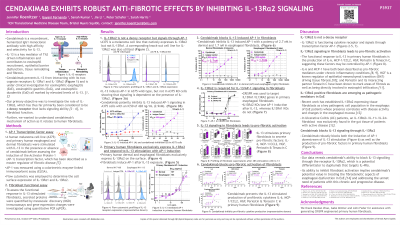Tuesday Poster Session
Category: Esophagus
P3937 - Cendakimab Exhibits Robust Anti-Fibrotic Effects by Inhibiting IL-13Rα2 Signaling
Tuesday, October 29, 2024
10:30 AM - 4:00 PM ET
Location: Exhibit Hall E

Has Audio
- GF
Gayani Fernando-Mehta, MSc
Bristol Myers Squibb
Princeton, NJ
Presenting Author(s)
Award: Presidential Poster Award
Jennifer Koenitzer, PhD1, Gayani Fernando-Mehta, MSc1, Sanah Kumar, MSc1, Jie Li, PhD2, Peter Schafer, PhD1, Sarah Harris, PhD2
1Bristol Myers Squibb, Princeton, NJ; 2Bristol Myers Squibb, San Diego, CA
Introduction: Cendakimab is an IgG1 monoclonal antibody targeting IL-13, which is a key mediator of type 2 inflammation and contributes to eosinophil recruitment, epithelial barrier dysfunction, and fibrosis. Cendakimab prevents IL-13 from binding to its two receptors, IL-13Rα1 and IL-13Rα2, and is under clinical investigation for eosinophilic esophagitis (EoE), a disease marked by elevated IL-13.
Our aims were to investigate the role of IL-13Rα2 (thus far considered a non-signaling decoy receptor) in fibroblast function, and to understand cendakimab’s mechanism of action as it relates to human fibroblasts.
Methods: A human cell line (A375) and primary human esophageal or dermal fibroblasts were stimulated with IL-13 in the presence or absence of cendakimab before assessing the Activator Protein-1 (AP-1) transcription factor, which is a master regulator of fibrotic disease. AP-1 was measured using an enzyme-linked immunosorbent assay (ELISA). IL-13Rα1 and IL-13Rα2 surface expression were determined by flow cytometry. To assess the functional response in IL-13 stimulated fibroblasts, secreted proteins were quantified by mesoscale discovery (MSD) immunoassays and gene expression was evaluated by quantitative PCR (qPCR).
Results: Results show that IL-13Rα2 is a signaling receptor whose stimulation with IL-13 leads to the induction of AP-1 in A375 cells. When the parental gene IL13RA2 is knocked out, signaling does not occur. Cendakimab blocks IL-13 induced AP-1 production.
Similar results were also noted in primary human esophageal and dermal fibroblasts. Cendakimab inhibits IL-13 induced AP-1 signaling with a potency of 2.9nM (A375) and 1.7nM or 2.7nM in esophageal or dermal fibroblasts, respectively.
IL-13 stimulation of primary human fibroblasts led to the production of the cytokine IL-6, the monocyte chemoattractant protein-1 (MCP-1), hepatocyte growth factor (HGF), as well as extracellular matrix proteins periostin and tenascin C, suggesting these factors may be controlled by AP-1. Cendakimab treatment inhibited the production of all these pro-fibrotic mediators.
Discussion: These experiments confirm that IL-13Rα2 is a signaling cytokine receptor whose engagement leads to the pro-fibrotic activation of primary human fibroblasts. Cendakimab’s ability to attenuate this behavior has important implications for its potential targeting the fibrostenotic aspects of esophageal dysfunction in EoE and addressing the unmet need of patients suffering from this chronic and progressive disease.
Disclosures:
Jennifer Koenitzer, PhD1, Gayani Fernando-Mehta, MSc1, Sanah Kumar, MSc1, Jie Li, PhD2, Peter Schafer, PhD1, Sarah Harris, PhD2. P3937 - Cendakimab Exhibits Robust Anti-Fibrotic Effects by Inhibiting IL-13Rα2 Signaling, ACG 2024 Annual Scientific Meeting Abstracts. Philadelphia, PA: American College of Gastroenterology.
Jennifer Koenitzer, PhD1, Gayani Fernando-Mehta, MSc1, Sanah Kumar, MSc1, Jie Li, PhD2, Peter Schafer, PhD1, Sarah Harris, PhD2
1Bristol Myers Squibb, Princeton, NJ; 2Bristol Myers Squibb, San Diego, CA
Introduction: Cendakimab is an IgG1 monoclonal antibody targeting IL-13, which is a key mediator of type 2 inflammation and contributes to eosinophil recruitment, epithelial barrier dysfunction, and fibrosis. Cendakimab prevents IL-13 from binding to its two receptors, IL-13Rα1 and IL-13Rα2, and is under clinical investigation for eosinophilic esophagitis (EoE), a disease marked by elevated IL-13.
Our aims were to investigate the role of IL-13Rα2 (thus far considered a non-signaling decoy receptor) in fibroblast function, and to understand cendakimab’s mechanism of action as it relates to human fibroblasts.
Methods: A human cell line (A375) and primary human esophageal or dermal fibroblasts were stimulated with IL-13 in the presence or absence of cendakimab before assessing the Activator Protein-1 (AP-1) transcription factor, which is a master regulator of fibrotic disease. AP-1 was measured using an enzyme-linked immunosorbent assay (ELISA). IL-13Rα1 and IL-13Rα2 surface expression were determined by flow cytometry. To assess the functional response in IL-13 stimulated fibroblasts, secreted proteins were quantified by mesoscale discovery (MSD) immunoassays and gene expression was evaluated by quantitative PCR (qPCR).
Results: Results show that IL-13Rα2 is a signaling receptor whose stimulation with IL-13 leads to the induction of AP-1 in A375 cells. When the parental gene IL13RA2 is knocked out, signaling does not occur. Cendakimab blocks IL-13 induced AP-1 production.
Similar results were also noted in primary human esophageal and dermal fibroblasts. Cendakimab inhibits IL-13 induced AP-1 signaling with a potency of 2.9nM (A375) and 1.7nM or 2.7nM in esophageal or dermal fibroblasts, respectively.
IL-13 stimulation of primary human fibroblasts led to the production of the cytokine IL-6, the monocyte chemoattractant protein-1 (MCP-1), hepatocyte growth factor (HGF), as well as extracellular matrix proteins periostin and tenascin C, suggesting these factors may be controlled by AP-1. Cendakimab treatment inhibited the production of all these pro-fibrotic mediators.
Discussion: These experiments confirm that IL-13Rα2 is a signaling cytokine receptor whose engagement leads to the pro-fibrotic activation of primary human fibroblasts. Cendakimab’s ability to attenuate this behavior has important implications for its potential targeting the fibrostenotic aspects of esophageal dysfunction in EoE and addressing the unmet need of patients suffering from this chronic and progressive disease.
Disclosures:
Jennifer Koenitzer: Bristol Myers Squibb – Employee, Stock Options, Stock-publicly held company(excluding mutual/index funds).
Gayani Fernando-Mehta: Bristol Myers Squibb – Employee, Stock Options, Stock-publicly held company(excluding mutual/index funds).
Sanah Kumar: Bristol Myers Squibb – Employee, Stock Options, Stock-publicly held company(excluding mutual/index funds).
Jie Li: Bristol Myers Squibb – Employee, Stock Options, Stock-publicly held company(excluding mutual/index funds).
Peter Schafer: Bristol Myers Squibb – Employee, Stock Options, Stock-privately held company.
Sarah Harris: Bristol Myers Squibb – Employee.
Jennifer Koenitzer, PhD1, Gayani Fernando-Mehta, MSc1, Sanah Kumar, MSc1, Jie Li, PhD2, Peter Schafer, PhD1, Sarah Harris, PhD2. P3937 - Cendakimab Exhibits Robust Anti-Fibrotic Effects by Inhibiting IL-13Rα2 Signaling, ACG 2024 Annual Scientific Meeting Abstracts. Philadelphia, PA: American College of Gastroenterology.

